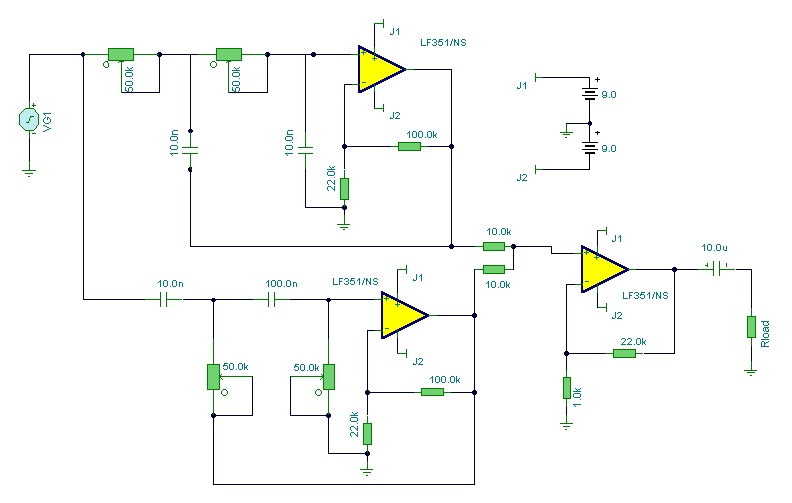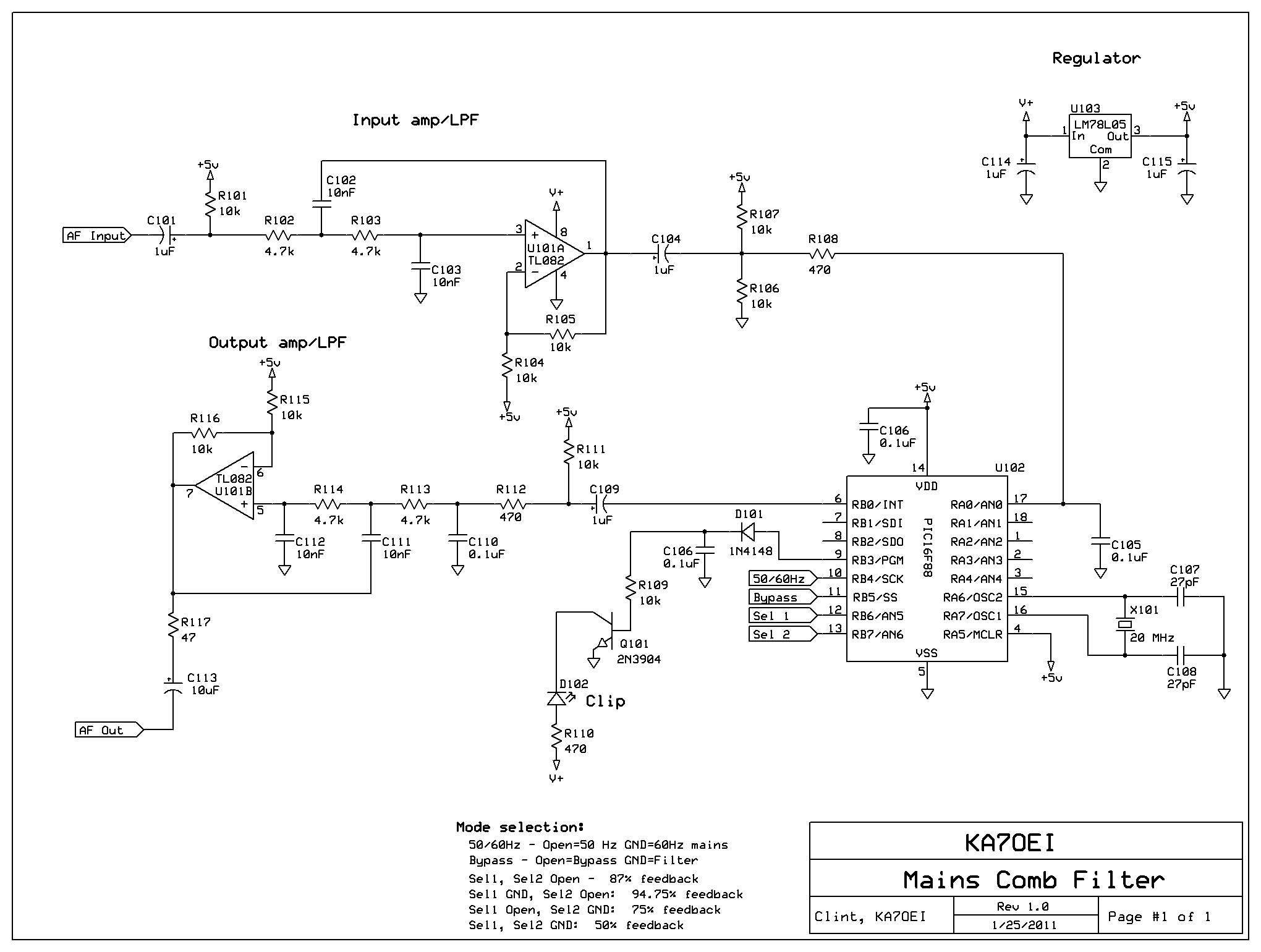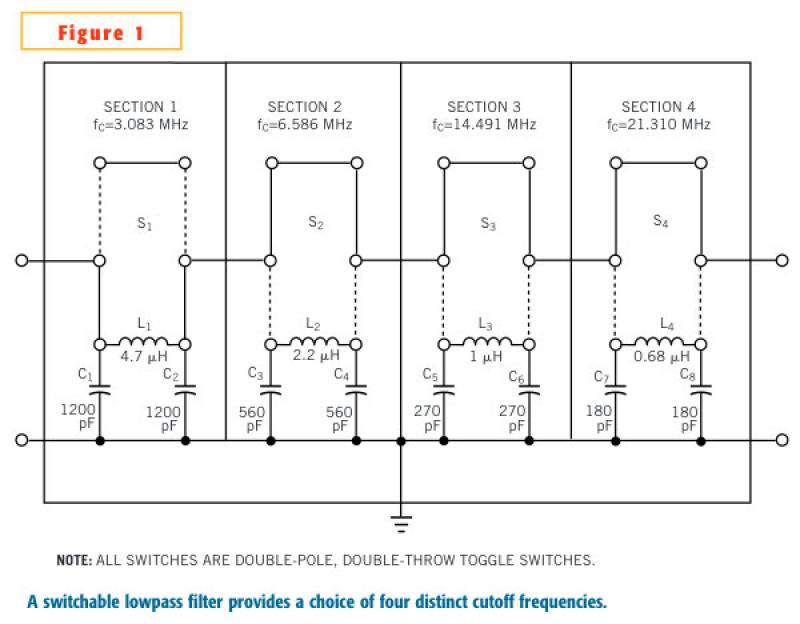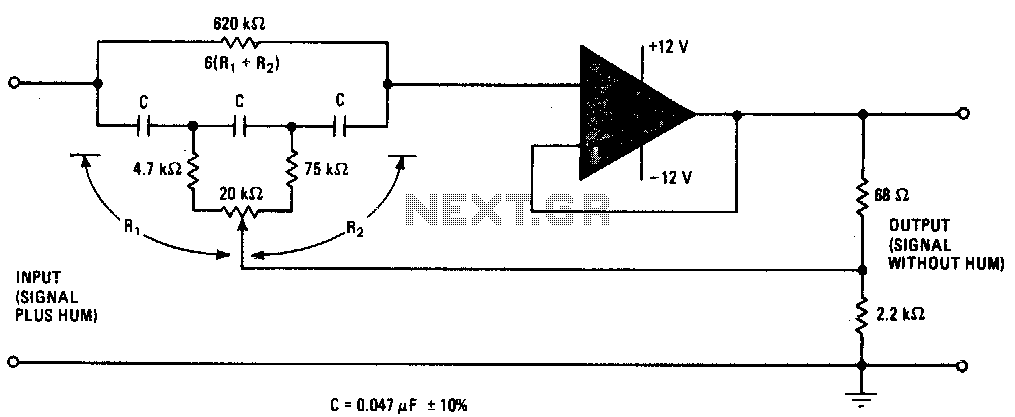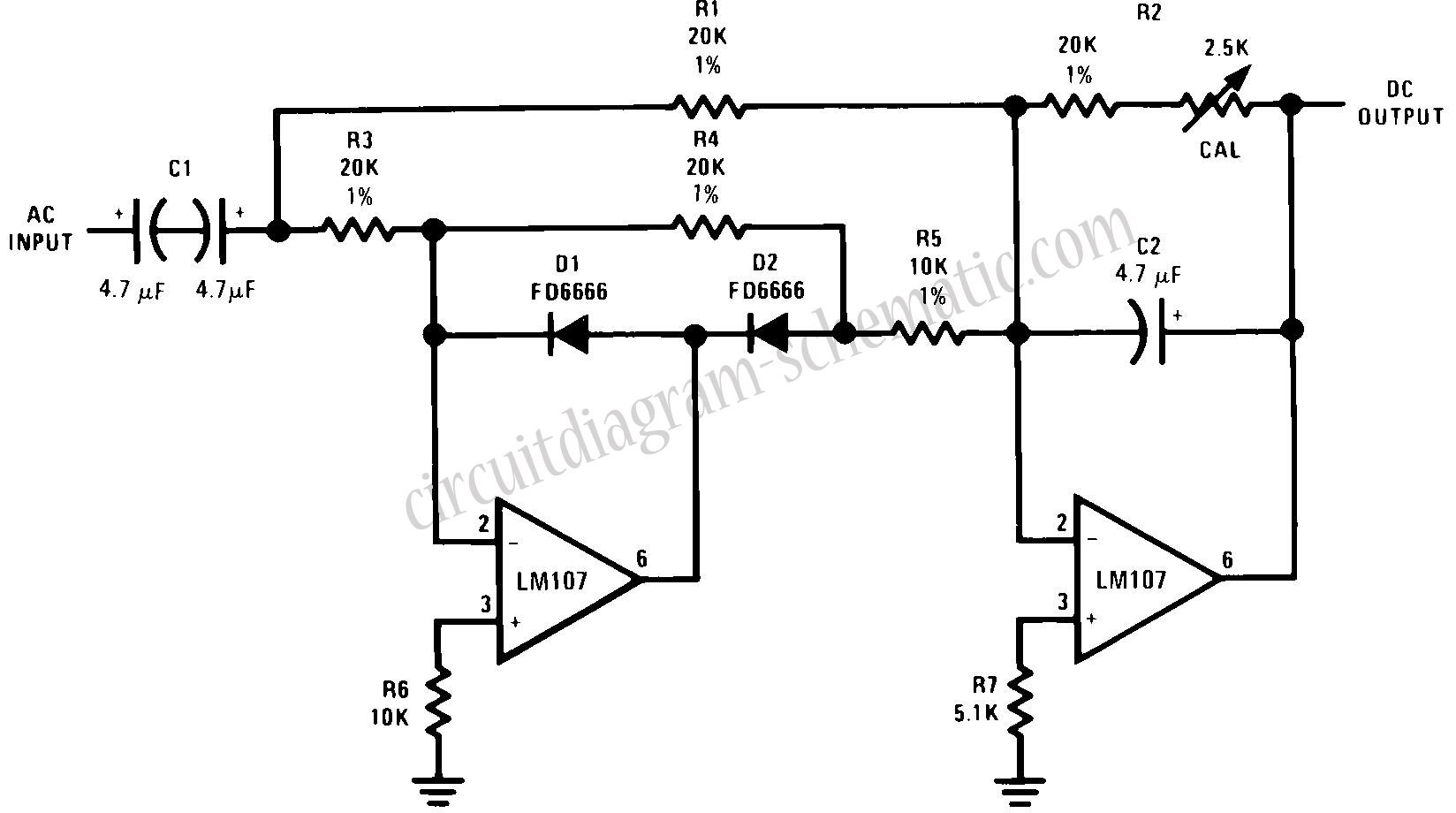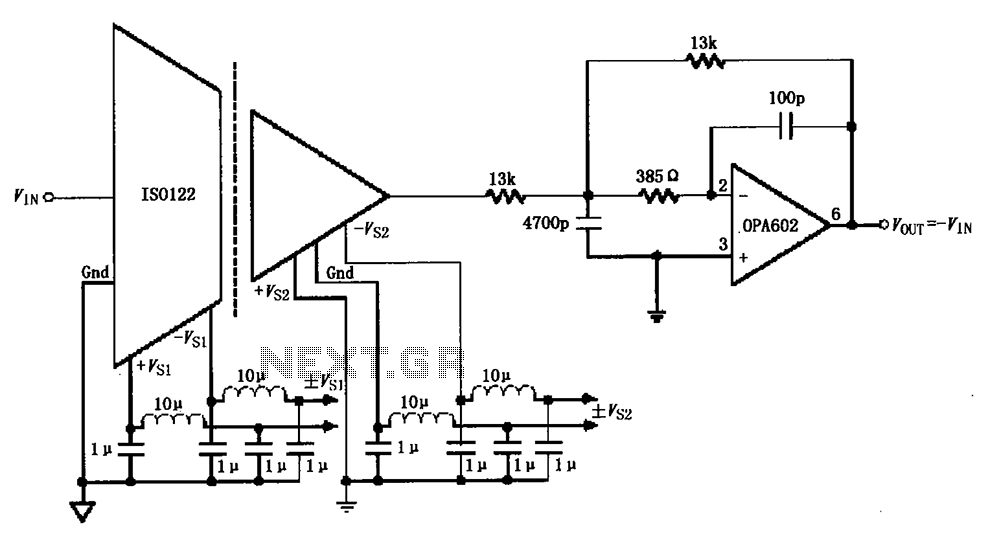
Voice Bandwidth Filter
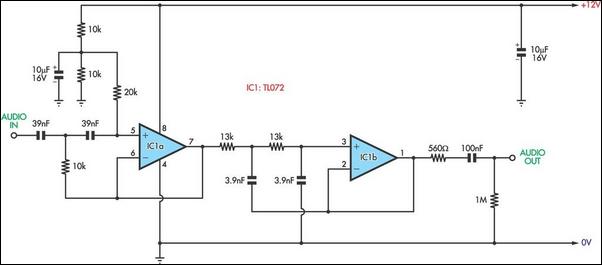
This circuit allows frequencies in the range of 300 Hz to 3.1 kHz, which are typical in human speech, to pass through. It is composed of cascaded high-pass and low-pass filters that together create a complete band-pass filter. One half of a TL072 dual op-amp (IC1a), along with two capacitors and two resistors, forms a second-order Sallen-Key high-pass filter. With the specified component values, the cut-off frequency (3 dB point) is approximately 300 Hz. Since the op-amp is powered from a single supply rail, two 10 kΩ resistors and a 10 µF decoupling capacitor are utilized to bias the input (pin 5) to half of the supply rail voltage. The output from IC1a is directed to the second half of the op-amp (IC1b), which is also configured as a Sallen-Key filter but operates as a low-pass filter with a cut-off frequency near 3.1 kHz. The values of the filter components were selected to achieve Butterworth response characteristics, ensuring maximum pass-band flatness. The overall voltage gain within the pass-band is unity (0 dB), and the maximum input signal level before clipping is about 3.5 V RMS. A 560 Ω resistor at the output of IC1b provides short-circuit protection.
This circuit operates within the audio frequency range, specifically tailored for processing human speech. The design employs a Sallen-Key topology, which is known for its simplicity and effectiveness in achieving desired filter characteristics. The high-pass section (IC1a) effectively removes low-frequency noise and unwanted signals below 300 Hz, while the low-pass section (IC1b) attenuates frequencies above 3.1 kHz, ensuring that only the desired frequency band is amplified.
The use of a TL072 dual op-amp is advantageous due to its low noise and high input impedance, which minimizes the loading effect on the preceding stage. The cascading of two Sallen-Key filters allows for a more precise control over the filter characteristics, and the choice of Butterworth response ensures a smooth transition at the cut-off frequencies, avoiding peaking that could distort the audio signal.
The biasing arrangement using two 10 kΩ resistors and a decoupling capacitor is essential for single-supply operation, allowing the op-amp to function correctly by establishing a virtual ground reference at half the supply voltage. This configuration supports the linear operation of the op-amp and enhances the overall performance of the circuit.
The output stage includes a 560 Ω resistor, which serves a critical role in protecting the circuit from potential short-circuits by limiting the output current. This feature is particularly important in applications where the circuit may be connected to varying loads, safeguarding the op-amp from damage due to excessive current draw.
In summary, this circuit is designed to effectively filter and amplify human speech frequencies, making it suitable for various audio processing applications, including communication devices and speech recognition systems. The careful selection of components and topology contributes to its reliability and performance in real-world scenarios.This circuit passes frequencies in the 300Hz - 3. 1kHz range, as present in human speech. The circuit consists of cascaded high-pass and low-pass filters, which together form a complete band-pass filter. One half of a TL072 dual op amp (IC1a) together with two capacitors and two resistors make up a second-order Sallen-Key high-pass filter.
With the values shown, the cut-off frequency (3dB point) is around 300Hz. As the op amp is powered from a single supply rail, two 10kO resistors and a 10 µF decoupling capacitor are used to bias the input (pin 5) to one-half supply rail voltage. The output of IC1a is fed into the second half of the op amp (IC1b), also configured as a Sallen-Key filter.
However, this time a low-pass function is performed, with a cut-off frequency of about 3. 1kHz. The filter component values were chosen for Butterworth response characteristics, providing maximum pass-band flatness. Overall voltage gain in the pass-band is unity (0dB), with maximum input signal level before clipping being approximately 3.
5V RMS. The 560O resistor at IC1b`s output provides short-circuit protection. 🔗 External reference
This circuit operates within the audio frequency range, specifically tailored for processing human speech. The design employs a Sallen-Key topology, which is known for its simplicity and effectiveness in achieving desired filter characteristics. The high-pass section (IC1a) effectively removes low-frequency noise and unwanted signals below 300 Hz, while the low-pass section (IC1b) attenuates frequencies above 3.1 kHz, ensuring that only the desired frequency band is amplified.
The use of a TL072 dual op-amp is advantageous due to its low noise and high input impedance, which minimizes the loading effect on the preceding stage. The cascading of two Sallen-Key filters allows for a more precise control over the filter characteristics, and the choice of Butterworth response ensures a smooth transition at the cut-off frequencies, avoiding peaking that could distort the audio signal.
The biasing arrangement using two 10 kΩ resistors and a decoupling capacitor is essential for single-supply operation, allowing the op-amp to function correctly by establishing a virtual ground reference at half the supply voltage. This configuration supports the linear operation of the op-amp and enhances the overall performance of the circuit.
The output stage includes a 560 Ω resistor, which serves a critical role in protecting the circuit from potential short-circuits by limiting the output current. This feature is particularly important in applications where the circuit may be connected to varying loads, safeguarding the op-amp from damage due to excessive current draw.
In summary, this circuit is designed to effectively filter and amplify human speech frequencies, making it suitable for various audio processing applications, including communication devices and speech recognition systems. The careful selection of components and topology contributes to its reliability and performance in real-world scenarios.This circuit passes frequencies in the 300Hz - 3. 1kHz range, as present in human speech. The circuit consists of cascaded high-pass and low-pass filters, which together form a complete band-pass filter. One half of a TL072 dual op amp (IC1a) together with two capacitors and two resistors make up a second-order Sallen-Key high-pass filter.
With the values shown, the cut-off frequency (3dB point) is around 300Hz. As the op amp is powered from a single supply rail, two 10kO resistors and a 10 µF decoupling capacitor are used to bias the input (pin 5) to one-half supply rail voltage. The output of IC1a is fed into the second half of the op amp (IC1b), also configured as a Sallen-Key filter.
However, this time a low-pass function is performed, with a cut-off frequency of about 3. 1kHz. The filter component values were chosen for Butterworth response characteristics, providing maximum pass-band flatness. Overall voltage gain in the pass-band is unity (0dB), with maximum input signal level before clipping being approximately 3.
5V RMS. The 560O resistor at IC1b`s output provides short-circuit protection. 🔗 External reference
